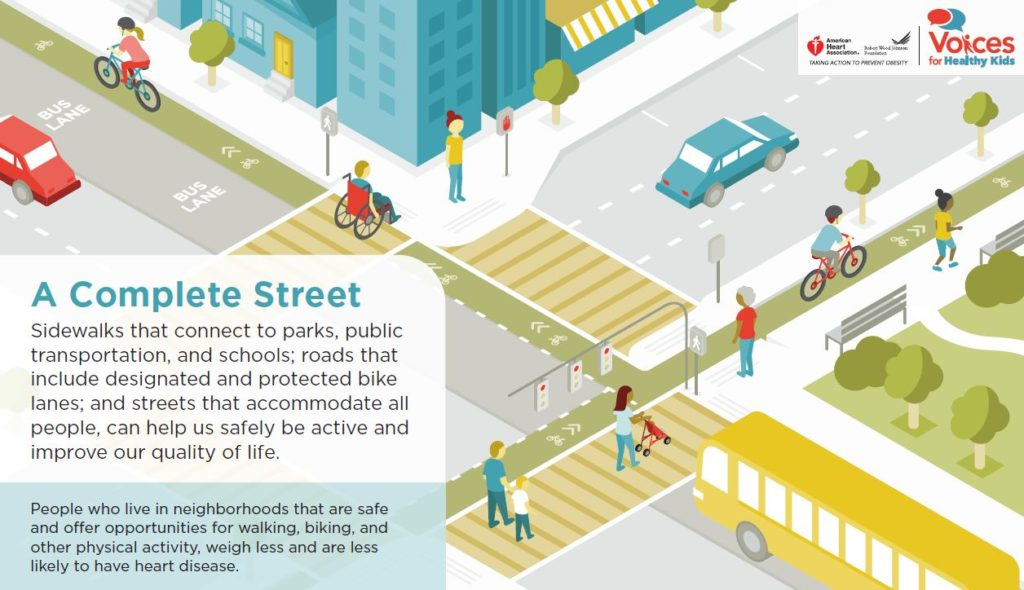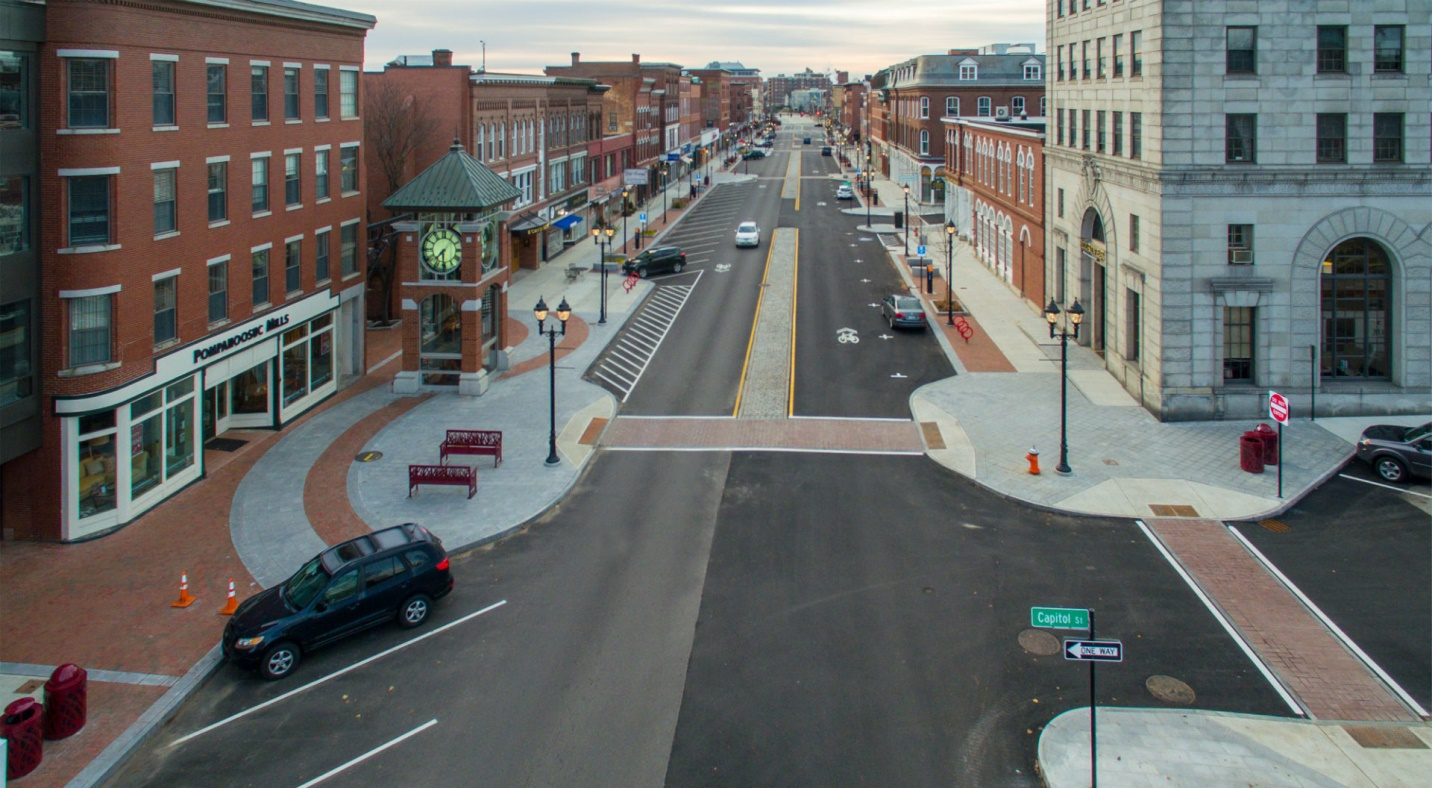The information contained in this article is not intended as legal advice and may no longer be accurate due to changes in the law. Consult NHMA's legal services or your municipal attorney.
Those of us in the planning world, at some point in the last few years, may have heard of the phrase “Complete Streets Program.” Your reaction could have been, “That’s too complicated or expensive for NH communities,” or, “Sounds great, but that’s for major metropolitan areas, where will that work in rural New Hampshire?” Well, the reality is Complete Streets have arrived in New Hampshire with several communities having already implemented Complete Street design techniques and a few more in the planning stages of creating a Complete Street network between communities. As the Complete Streets program becomes better known, hopefully more New Hampshire communities and state agencies will begin utilizing its design standards in their regulations so the program can continue to expand throughout the state.
Let’s look at what the Complete Streets Program is all about and where it comes from.
Complete Streets is a nationwide program that is part of the Smart Growth America Coalition. Smart Growth is an urban planning and transportation theory that concentrates growth in compact walkable urban centers to avoid sprawl. It also advocates compact, transit-oriented, walkable, bicycle-friendly land uses, including neighborhood schools, complete streets, and mixed use development with a range of housing choices. The goal of Complete Streets is to integrate people and safety into the planning, design, construction, operation, and maintenance of our transportation networks. This helps to ensure that streets are safe for people of all ages and abilities, help balance the needs of different transportation modes, and support local land uses, economies, cultures, and natural environments.
The decision to utilize Complete Streets can be based on an individual community’s needs to address a broad range of safety and access issues such as: sidewalks, bicycle lanes, bus lanes, pedestrian crossings, transportation stops, median islands, curb extensions, traffic calming, and landscaping features. The safety features of Complete Streets designs are based on separating the types of transportation so they can function independently from other modes of transportation and yet still remain as part of the same transportation system. This is achieved by creating separate bicycle, automobile, and bus lanes; creating pedestrian islands, safe access for walking and crossing the street, and include landscaping and traffic calming features.

Photo courtesy of the American Heart Association and Voices for Healthy Kids
The numerous benefits of a Complete Streets program include: safety, environmental, health, and increases in economic development and business activities. People are more apt to walk, bicycle, take public transportation for work, to shop, and dine out when there is safe, accessible transportation for them. Walking and riding bicycles to work and utilizing public transportation have obvious environmental and health benefits, but what may not be an obvious benefit are the economic benefits to communities with Complete Streets programs.
According to the City of Concord’s Department of Development before the city reconstructed Main Street by utilizing Complete Streets design standards, their commercial vacancy rate for downtown ground floor space was 10.9 percent. After construction was completed, the commercial vacancy rate for downtown ground floor space went down to 5.5 percent and 13 new businesses opened during construction.

City of Concord's Complete Streets Design Conceptual
Another benefit of Complete Streets is that it is not a “one size fits all” program. It can be easily tailored to any size community. Some examples of communities in New Hampshire that are in the process of or have already adopted and implemented Complete Streets policies are: Concord, Portsmouth, Keene, Dover, Nashua, Littleton, Swanzey, and Jaffrey.
You may be wondering, “How do we start the process of utilizing a Complete Streets program?” One option for communities would be to contact their Regional Planning Commissions (RPC) for technical assistance. Each RPC is well versed and experienced in transportation issues and trends within their regions and are quite adept at identifying individual transportation and safety needs of their member communities. The Southwest Regional Planning Commission so far has nine (9) communities within their region that have incorporated Complete Streets programs.
The Strafford Regional Planning Commission is currently working with NH Department of Transportation (NHDOT) and the cities of Dover, Rochester, and Somersworth on a “Complete Street 108” corridor study. This study will incorporate Complete Streets design standards to address public transportation access and safety issues along the route. Communities can also work with their RPC through their Transportation Advisory Committee to incorporate Complete Streets design standards within other state or federal grant application programs like Safe Routes to School , Better Utilizing Investments to Leverage Development Transportation Discretionary Grants program, and the State Transportation Improvement Program.
Communities can utilize Complete Streets policies either within their land use regulations or through adoption by the governing body. They can also consider utilizing Complete Streets standards as part of their Capital Improvements Program for roads, sidewalks, and other safety and access improvements as well as request that the NHDOT incorporate Complete Streets design standards when any type of road or sidewalk project is about to begin in their community. Even when repaving a town or state road, Complete Streets design standards can be incorporated.
Changing our minds and regulations toward adopting Complete Streets policies and practices will be beneficial for the overall health, safety, environment, and economy for New Hampshire residents, visitors, and our communities.
For more information and resources, please visit NH OSI’s Complete Streets web page at https://www.nh.gov/osi/resource-library/transportation/index.htm.
https://www.transportation.gov/mission/health/complete-streets
https://smartgrowthamerica.org/program/national-complete-streets-coalition/
https://www.108tricitycompletestreets.com/index.htm
https://www.healnh.org/index.php/newsroom/news/594-a-move-toward-complete-streets-in-nh
Stephanie N. Verdile is a Principal Planner with the New Hampshire Office of Strategic Initiatives. Stephanie can be reached by phone at 603.271.1765 or by email at stephanie.verdile@osi.nh.gov.